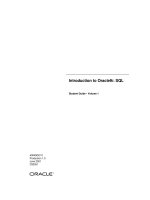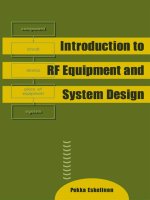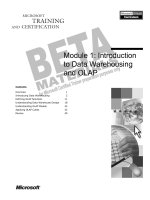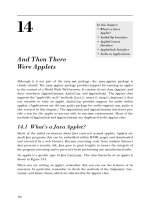Introduction to Oracle: SQL and PL/SQL Using Procedure Builder potx
Bạn đang xem bản rút gọn của tài liệu. Xem và tải ngay bản đầy đủ của tài liệu tại đây (1.81 MB, 322 trang )
Introduction to Oracle: SQL
and PL/SQL Using Procedure
Builder
Volume One S Participant Guide
Edition 1.1
M03989
T1001E11
Authors
Neena Kochhar
Debby Kramer
Technical Contributors
and Reviewers
Christian Bauwens
Debra Bowman
Lenny Brunson
Jackie Collins
Ralf Durben
Brian Fry
Anthony Holbrook
Karlene Jensen
Sarah Jones
Glenn Maslen
Sundar Nagarathnam
Sandra Schrick
Ulrike Schwinn
Rosemarie Truman
Jenny Tsai
Laura Van Deusen
Publishers
Stephanie Jones
Kimberly Lee
Jennifer Robertson
Mark Turangan
Copyright EĂOracle Corporation, 1992, 1996. All rights reserved.
This documentation contains proprietary information of Oracle Corporation; it is
provided under a license agreement containing restrictions on use and discloĆ
sure and is also protected by copyright law. Reverse engineering of the software
is prohibited. If this documentation is delivered to a U.S. Government Agency of
the Department of Defense, then it is delivered with Restricted Rights and the folĆ
lowing legend is applicable:
Restricted Rights Legend
Use, duplication or disclosure by the Government is subject to restrictions for
commercial computer software and shall be deemed to be Restricted Rights softĆ
ware under Federal law, and as set forth in subparagraph (c) (1) (ii) of DFARS
252.227Ć7013, Rights in Technical Data and Computer Software (October 1988).
This material or any portion of it may not be copied in any form or by any means
without the express prior written permission of the Worldwide Education Services
group of Oracle Corporation. Any other copying is a violation of copyright law and
may result in civil and/or criminal penalties.
If this documentation is delivered to a U.S. Government Agency not within the DeĆ
partment of Defense, then it is delivered with Restricted Rights," as defined in
FAR 52.227Ć14, Rights in DataĆGeneral, including Alternate III (June 1987).
The information in this document is subject to change without notice. If you find
any problems in the documentation, please report them in writing to Worldwide
Education Services, Oracle Corporation, 500 Oracle Parkway, Box 659806, RedĆ
wood Shores, CA 94065. Oracle Corporation doesnot warrant that this document
is error free.
SQL*Plus, PL/SQL, Procedure Builder, Developer/2000, Oracle7 Server, Oracle
Server, Discoverer/2000, and Designer/2000 are trademarks or registered tradeĆ
marks of Oracle Corporation.
All other products or company names are used for identification purposes only,
and may be trademarks of their respective owners.
iii
Contents
Volume 1
Preface xi
Profile xii
Related Publications xviii
Typographic Conventions xix
I Introduction IĆ1
Course Objectives IĆ3
Course Outline IĆ5
The Relational Database Concept IĆ9
System Development Cycle IĆ17
What Is Oracle? IĆ19
The Oracle Product Set IĆ21
SQL, SQL*Plus, and PL/SQL IĆ23
Summit Sporting Goods Demonstration Tables IĆ29
Summary IĆ33
1. Selecting Rows 1Ć1
Objectives 1Ć3
The Basic Query Block 1Ć5
Arithmetic Expressions 1Ć13
Column Aliases 1Ć21
The Concatenation Operator 1Ć23
Literal Character String 1Ć25
Managing Null Values 1Ć27
Preventing the Selection of Duplicate Rows 1Ć31
SQL*Plus Commands 1Ć35
Logging in to SQL*Plus 1Ć37
Displaying Table Structure 1Ć39
SQL*Plus Editing Commands 1Ć41
SQL*Plus File Commands and Online Help 1Ć43
Creating a Report 1Ć45
Summary 1Ć51
Practice Overview 1Ć53
Practice 1 1Ć55
2. Limiting Selected Rows 2Ć1
Objectives 2Ć3
Ordering Rows with the ORDER BY Clause 2Ć5
Limiting Selected Rows with the WHERE Clause 2Ć11
Comparison Operators 2Ć13
iv
Negating Expressions 2Ć17
SQL Operators 2Ć19
Querying Data with Multiple Conditions 2Ć27
Rules of Precedence 2Ć29
Summary 2Ć33
Practice Overview 2Ć35
Practice 2 2Ć37
3. Single Row Functions 3Ć1
Objectives 3Ć3
Overview 3Ć5
Single Row Functions 3Ć7
Character Functions 3Ć9
Number Functions 3Ć17
Oracle Date Format 3Ć23
Using Arithmetic Operators with Dates 3Ć25
Date Functions 3Ć27
Conversion Functions 3Ć33
TO_CHAR Function with Date Formats 3Ć35
TO_CHAR Function with Number Formats 3Ć45
TO_NUMBER and TO_DATE Functions 3Ć49
Nesting Single Row Functions 3Ć51
Nesting Functions 3Ć53
Summary 3Ć55
Practice Overview 3Ć57
Practice 3 3Ć59
4. Displaying Data from Multiple Tables 4Ć1
Objectives 4Ć3
Overview 4Ć5
What Is a Cartesian Product? 4Ć7
Simple Join Query 4Ć9
Using Table Aliases 4Ć17
NonĆEquijoin 4Ć19
Returning Records with No Direct Match 4Ć21
Joining a Table to Itself 4Ć25
Summary 4Ć27
Practice Overview 4Ć29
Practice 4 4Ć31
5. Group Functions 5Ć1
Objectives 5Ć3
Overview 5Ć5
Group Functions 5Ć7
v
The GROUP BY Clause 5Ć13
Illegal Queries Using Group Functions 5Ć19
Groups Within Groups 5Ć23
The HAVING Clause 5Ć25
Summary 5Ć31
Practice Overview 5Ć33
Practice 5 5Ć34
6. Subqueries 6Ć1
Objectives 6Ć3
Overview 6Ć5
Subqueries 6Ć7
How Are Nested Subqueries Processed? 6Ć9
Single Row Subqueries 6Ć11
Errors with Subqueries 6Ć15
Multiple Row Subqueries 6Ć17
HAVING Clause with Nested Subqueries 6Ć19
Summary 6Ć21
Practice Overview 6Ć23
Practice 6 6Ć25
Volume 2
7. Specifying Variables at Runtime 7Ć1
Objectives 7Ć3
Overview 7Ć5
Substitution Variables 7Ć7
Single Ampersand Substitution Variables 7Ć9
Defining User Variables 7Ć15
Passing Values into a Script File 7Ć21
Summary 7Ć23
Practice Overview 7Ć25
Practice 7 7Ć26
8. Overview of Data Modeling and Database Design 8Ć1
Objectives 8Ć3
Overview 8Ć5
System Development Cycle 8Ć7
Database Design 8Ć9
Data Model 8Ć11
Entity Relationship Modeling 8Ć13
Entity Relationship Model Concepts 8Ć15
Integrity Constraints and Keys 8Ć23
Designing the Database 8Ć29
Summary 8Ć39
vi
9. Creating Tables 9Ć1
Objectives 9Ć3
Overview 9Ć5
Creating Tables 9Ć7
Oracle7 Datatypes 9Ć13
Constraints 9Ć15
Creating a Table from a Table Instance Chart 9Ć25
Creating a Table from Rows in Another Table 9Ć31
Confirming Table Creation 9Ć33
Summary 9Ć35
Practice Overview 9Ć37
Practice 9 9Ć39
10. Oracle Data Dictionary 10Ć1
Objectives 10Ć3
Overview 10Ć5
Querying the Data Dictionary 10Ć7
Checking Constraints on a Table 10Ć13
Summary 10Ć17
Practice Overview 10Ć19
Practice 10 10Ć21
11. Manipulating Data 11Ć1
Objectives 11Ć3
Overview 11Ć5
Adding a New Row to a Table 11Ć7
Copying Rows from Another Table 11Ć19
Updating Rows 11Ć21
Deleting Rows 11Ć29
Transaction Processing 11Ć35
Committing Changes 11Ć39
Rolling Back Changes 11Ć43
Rolling Back Changes to a Savepoint 11Ć45
Statement Level Rollback 11Ć47
Summary 11Ć49
Practice Overview 11Ć51
Practice 11 11Ć53
12. Altering Tables and Constraints 12Ć1
Objectives 12Ć3
Overview 12Ć5
Adding a Column 12Ć7
Modifying a Column 12Ć9
Adding and Dropping a Constraint 12Ć11
vii
Disabling and Enabling a Constraint 12Ć15
Dropping a Table 12Ć17
Renaming and Truncating a Table 12Ć19
Adding a Comment to a Table 12Ć21
Summary 12Ć23
Practice Overview 12Ć25
Practice 12 12Ć27
13. Creating Sequences 13Ć1
Objectives 13Ć3
Overview 13Ć5
Creating a Sequence 13Ć7
Using a Sequence 13Ć13
Altering a Sequence 13Ć17
Removing a Sequence 13Ć19
Summary 13Ć21
Practice Overview 13Ć23
Practice 13 13Ć25
14. Creating Views 14Ć1
Objectives 14Ć3
Overview 14Ć5
Creating a View 14Ć7
Performing DML Operations on a View 14Ć15
Confirming View Names and Structures 14Ć21
Removing a View 14Ć23
Summary 14Ć25
Practice Overview 14Ć27
Practice 14 14Ć29
15. Creating Indexes 15Ć1
Objectives 15Ć3
Overview 15Ć5
When Is the Index Used? 15Ć7
Index Structure 15Ć9
Creating an Index 15Ć13
Confirming Indexes 15Ć17
Removing an Index 15Ć19
Summary 15Ć21
Practice Overview 15Ć23
Practice 15 15Ć25
16. Controlling User Access 16Ć1
Objectives 16Ć3
Overview 16Ć5
viii
System Privileges 16Ć7
What Is a Role? 16Ć11
Changing Your Password 16Ć13
Granting Object Privileges 16Ć15
Confirming Privileges Granted 16Ć21
Revoking Object Privileges 16Ć23
Creating a Synonym for an Object 16Ć25
Summary 16Ć29
Practice Overview 16Ć31
Practice 16 16Ć33
17. Summary of SQL and SQL*Plus 17Ć1
Summary of SQL and SQL*Plus 17Ć3
Practice Overview 17Ć9
Practice 17 17Ć11
Volume 3
18. Overview of PL/SQL 18Ć1
Objectives 18Ć3
Overview 18Ć5
PL/SQL Block Structure 18Ć9
The PL/SQL Environment 18Ć15
About Procedure Builder 18Ć17
19. Basics of Procedure Builder 19Ć1
Objectives 19Ć3
Overview 19Ć5
Oracle Procedure Builder Capabilities 19Ć7
Procedure Builder Components 19Ć9
The Object Navigator 19Ć15
The Interpreter 19Ć23
The Program Unit Editor 19Ć27
The Stored Program Unit Editor 19Ć31
Debugging a Stored Program Unit 19Ć33
Performing Debug Actions in the Interpreter 19Ć35
Setting a Breakpoint 19Ć37
Examining Local Variables 19Ć43
Summary 19Ć45
Practice Overview 19Ć47
Practice 19 19Ć49
20. Modularizing Programming with Subprograms 20Ć1
Objectives 20Ć3
Overview 20Ć5
ix
Creating a Subprogram 20Ć7
Creating a Procedure 20Ć9
Comparing Functions and Procedures 20Ć15
Creating a Function 20Ć17
Invoking Subprograms 20Ć21
Summary 20Ć29
Practice Overview 20Ć31
Practice 20 20Ć33
21. Developing a Simple PL/SQL Block 21Ć1
Objectives 21Ć3
Overview 21Ć5
Declaring PL/SQL Variables and Constants 21Ć7
Declaring Scalar Variables 21Ć9
Declaring Composite Datatypes 21Ć15
PL/SQL Block Syntax Rules 21Ć25
Assigning Values to Variables 21Ć29
Programming Guidelines 21Ć43
Summary 21Ć49
Practice Overview 21Ć51
Practice 21 21Ć53
22. Interacting with Oracle 22Ć1
Objectives 22Ć3
Overview 22Ć5
Retrieving Data Using PL/SQL 22Ć7
SELECT Exceptions 22Ć15
Manipulating Data Using PL/SQL 22Ć19
SQL Cursor 22Ć23
Controlling Transactions 22Ć27
Summary 22Ć31
Practice Overview 22Ć33
Practice 22 22Ć35
23. Controlling Flow in PL/SQL Blocks 23Ć1
Objectives 23Ć3
Overview 23Ć5
The IF Statement 23Ć7
Building Logical Conditions 23Ć13
Loop Statements 23Ć17
Summary 23Ć29
Practice Overview 23Ć31
Practice 23 23Ć33
x
24. Processing Queries by Using Explicit Cursors 24Ć1
Objectives 24Ć3
Overview 24Ć5
Controlling Explicit Cursors 24Ć7
Explicit Cursor Attributes 24Ć17
Cursors and Records 24Ć21
Cursors with Parameters 24Ć23
Cursor FOR Loops 24Ć25
Applying the WHERE CURRENT OF Clause 24Ć27
Summary 24Ć29
Practice Overview 24Ć31
Practice 24 24Ć33
25. Error Handling 25Ć1
Objectives 25Ć3
Overview 25Ć5
Exception Types 25Ć7
Trapping Exceptions 25Ć9
Trapping Predefined Oracle7 Server Exceptions 25Ć11
Trapping NonĆPredefined Oracle7 Server Exceptions 25Ć15
Trapping UserĆDefined Exceptions 25Ć17
Error Trapping Functions 25Ć19
Propagating Exceptions 25Ć21
Summary 25Ć23
Practice Overview 25Ć25
Practice 25 25Ć27
26. Summary of PL/SQL 26Ć1
Summary 26Ć3
Practice Overview 26Ć9
Practice 26 26Ć11
Volume 4
A Practice Solutions AĆ1
Preface AĆ3
Practice 1 Solutions AĆ4
Practice 2 Solutions AĆ8
Practice 3 Solutions AĆ20
Practice 4 Solutions AĆ29
Practice 5 Solutions AĆ39
Practice 6 Solutions AĆ46
Practice 7 Solutions AĆ55
Practice 9 Solutions AĆ59
Practice 10 Solutions AĆ63
xi
Practice 11 Solutions AĆ68
Practice 12 Solutions AĆ82
Practice 13 Solutions AĆ88
Practice 14 Solutions AĆ97
Practice 15 Solutions AĆ105
Practice 16 Solutions AĆ109
Practice 17 Solutions AĆ116
Practice 19 Solutions AĆ154
Practice 20 Solutions AĆ155
Practice 21 Solutions AĆ158
Practice 22 Solutions AĆ163
Practice 23 Solutions AĆ170
Practice 24 Solutions AĆ177
Practice 25 Solutions AĆ186
Practice 26 Solutions AĆ192
B Table Descriptions and Data BĆ1
Summit Sporting Goods Database Diagram BĆ3
S_CUSTOMER Table BĆ4
S_DEPT Table BĆ7
S_EMP Table BĆ8
S_IMAGE Table BĆ10
S_INVENTORY Table BĆ11
S_ITEM Table BĆ16
S_ORD Table BĆ20
S_PRODUCT Table BĆ22
S_REGION Table BĆ25
S_WAREHOUSE Table BĆ26
C Using SQL*Plus to Create Reports and Manage PL/SQL Code CĆ1
Objectives CĆ3
Overview CĆ5
Entering Commands in SQL*Plus CĆ7
Comparison of SQL and SQL*Plus Commands CĆ9
SQL*Plus SET Commands CĆ11
Creating a Report CĆ15
Declaring and Creating PL/SQL Blocks CĆ23
Entering Commands in SQL*Plus CĆ25
Passing Input and Output Values CĆ27
Debugging in SQL*Plus CĆ31
Displaying Contents of a Subprogram CĆ35
Executing Stored Subprograms CĆ37
Summary CĆ41
Practice Overview CĆ43
xii
Practice C CĆ45
Practice C Solutions CĆ47
D Related Products and Services DĆ1
Related Products DĆ3
Related Services DĆ5
Glossary
Index
Preface
Introduction to Oracle: SQL and PL/SQL Using Procedure Builderxiv
Profile
Before You Begin This Course
Before you begin this course, you should be able to use a graphical user interface
(GUI). Required prerequisites are familiarity with data processing concepts and
techniques.
How This Course Is Organized
Introduction to Oracle: SQL and PL/SQL Using Procedure Builder is an
instructor-led course featuring lecture and hands-on exercises. The concepts and skills
introduced are reinforced by online demonstrations and written practice sessions.
How This Book Is Organized
Lesson
Aim
Lesson 1: Selecting Rows In order to extract data from the database
you need to use the Structured Query
Language (SQL) SELECT command.
You will want to create SELECT
statements that you can use time and
time again. You will also see how to save
your statements for later use.
Lesson 2: Limiting Selected Rows This lesson will cover how to restrict the
rows and columns that are displayed, as
well as how to specify the order in which
the rows are presented.
Preface xv
Profile continued
Lesson Aim
Lesson 3: Single Row Functions Functions make the basic query block
more powerful and are used to
manipulate data values. This is the first
of two lessons that explore functions.
You will focus on single row character,
number, and date functions, as well as
those functions that convert data from
one type to another, for example,
character data to numeric.
Lesson 4: Displaying Data from Multiple
Tables
This lesson will cover how to obtain data
from more than one table, using the
many different methods available.
Lesson 5: Group Functions This lesson further addresses functions.
You will focus on obtaining summary
information, such as averages, for groups
of rows. You will discuss how to group
rows in a table into smaller sets, and how
to specify search criteria for groups of
rows.
Lesson 6: Subqueries This lesson covers more advanced
features of the SELECT statement. You
can write subqueries in the WHERE
clause of another SQL statement to
obtain values based on an unknown
conditional value.
Lesson 7: Specifying Variables at
Runtime
You can create a command file
containing a WHERE clause to restrict
the rows displayed. To change the
condition each time the command file is
run, you use substitution variables.
Substitution variables can replace values
in the WHERE clause, a text string, and
even a column or a table name.
Introduction to Oracle: SQL and PL/SQL Using Procedure Builderxvi
Profile continued
Lesson Aim
Lesson 8: Overview of Data Modeling
and Database Design
Before you build your tables, you design
your database. You examine the data
modeling process and relational database
concepts, and define normalization. You
also translate an entity relationship
model into a relational database design.
Lesson 9: Creating Tables You will create tables. You will also
build integrity constraints, which are
rules governing what can and cannot be
done with the data.
Lesson 10: Oracle Data Dictionary The Oracle data dictionary is one of the
most important components of the
Oracle7 Server. It consists of a set of
tables and views that provide a read-only
reference to the database.
Lesson 11: Manipulating Data Once your tables have been created, you
will need to add new rows, make
changes to rows in a table, or delete rows
by using data manipulation commands.
This lesson covers using SQL commands
to make changes to data. A number of
these data manipulation commands make
up a transaction, which you may either
save or delete using transaction controls.
Lesson 12: Altering Tables and
Constraints
After you create your tables, you may
need to change the table structures
because you omitted a column, your
column definition needs to be changed,
or you want to enable or disable
constraints. This lesson will demonstrate
how you can amend table structures as
well as add and remove constraints.
Preface xvii
Profile continued
Lesson Aim
Lesson 13: Creating Sequences Many applications require the use of
unique numbers as primary key values.
You can either build code into the
application to handle this requirement or
use a sequence to generate unique
numbers. This lesson covers creating and
using sequences that crate unique
numbers.
Lesson 14: Creating Views In this lesson, you will see how views
can be used to present data to users in a
variety of ways. In addition, you will see
how integrity constraints can be
enforced, if using a view to insert,
update, or delete data.
Lesson 15: Creating Indexes If you want to improve the performance
of some queries, you should consider
creating an index. You can also use
indexes to enforce uniqueness on a
column or a collection of columns.
Lesson 16: Controlling User Access This lesson describes the Oracle7 Server
decentralized security system. Using the
commands covered in this lesson, you
can control database access to specific
objects and add new users with different
levels of access privileges. You can
provide alternative names for objects by
using the CREATE SYNONYM
command.
Introduction to Oracle: SQL and PL/SQL Using Procedure Builderxviii
Profile continued
Lesson Aim
Lesson 17: Summary of SQL and
SQL*Plus (optional)
This lesson reviews the basic commands
covered in the course so far.
Lesson 18: Overview of PL/SQL Overview lesson of how to create and
use PL/SQL program units and
subprograms using Oracle Procedure
Builder.
Lesson 19: Basics of Procedure Builder A key feature of procedural
programming is the ability to create and
debug code quickly and easily.
Procedure Builder provides all of the
functionality necessary for you to
successfully develop and debug PL/SQL
programs. This lesson enables you to
manipulate PL/SQL code using
Procedure Builder.
Lesson 20: Modularizing Programming
with Subprograms
Modularity allows you to break your
code into manageable, well-defined
units. Each of these units in PL/SQL has
two types of subprograms called
procedures and functions. You will learn
the structure of subprograms and how to
invoke them.
Lesson 21: Developing a Simple
PL/SQL Block
Create a simple PL/SQL block after
learning the various elements that
compose a block.
Lesson 22: Interacting with Oracle Access the database and control
transactions through SQL statements in
PL/SQL.
Preface xix
Profile continued
Lesson Aim
Lesson 23: Using Control Structures Control the flow of your PL/SQL block
by using conditional statements and
loops.
Lesson 24: Processing Queries with
Explicit Cursors
Use a multiple row SELECT statement
within PL/SQL to process many rows.
Declare and control explicit cursors,
which are used in loops, including the
cursor FOR loop.
Lesson 25: Error Handling When you execute PL/SQL code, you
may encounter errors. The error causes
the PL/SQL block to halt with an
exception. You can trap the exception
and perform actions conditionally using
exception handlers.
Lesson 26: Summary of PL/SQL
(optional)
Review the topics covered in the course.
Create a PL/SQL-based application for
manipulating and maintaining
information in your database.
Introduction to Oracle: SQL and PL/SQL Using Procedure Builderxx
Related Publications
Oracle Publications
Title
Part Number
Oracle7 Server SQL Reference, Release 7.3 A32538
SQL*Plus User’s Guide and Reference, Release 3.3 A42562–1
PL/SQL User’s Guide and Reference, Release 2.3 A32542
Oracle7 Server SQL Language Quick Reference 5421–70–1292
SQL*Plus Quick Reference, Release 3.3 A42561
Oracle Procedure Builder 1.5 Developer’s Guide A32485
Oracle7 Server Concepts Manual, Release 7.3 A32534
Oracle Press: Oracle Beginner’s Guide A31178–1
Oracle Press: Oracle Complete Reference A10197–1
Additional References
D System Release Bulletins
D Installation and User’s Guides
D read.me Files
D International Oracle User’s Group (IOUG) Articles
D Oracle Magazine
Preface xxi
Typographic Conventions
Typographic Conventions Within Text
Convention
Object or Term Example
Uppercase Commands,
functions,
column names,
table names,
PL/SQL objects,
schemas
Use the SELECT command to view
information stored in the LAST_NAME
column of the S_EMP table.
Lowercase,
italic
File names,
syntax variables,
usernames,
passwords
where: role is the name of the role to be
created.
Initial cap Triggers and
button names
Assign a When–Validate–Item trigger to the
S_ORD block.
Press the Cancel button.
Italic Books, names of
courses and
manuals, and
emphasized
words or phrases
For further information on the subject see:
Oracle7 Server SQL Language Reference
Manual
Do not save changes to the database.
Quotation marks Lesson module
titles referenced
within a course
This subject is covered in Lesson 3, “Working
with Objects.”
Italic bold The first time a
glossary word is
referred to in a
section
The algorithm inserts the new key.
Introduction to Oracle: SQL and PL/SQL Using Procedure Builderxxii
Typographic Conventions continued
Typographic Conventions Within Code
Convention
Object or Term Example
Uppercase Commands,
functions
SQL> SELECT userid
2 FROM s_emp;
Lowercase,
italic
Syntax variables SQL> CREATE ROLE role;
Lowercase Column names,
table names, file
names, PL/SQL
objects
. . .
OG_ACTIVATE_LAYER
(OG_GET_LAYER (’prod_pie_layer’))
. . .
SQL> SELECT last_name
2 FROM s_emp;
SQLDBA> DROP USER scott
2> IDENTIFIED BY tiger;
Bold Text that must
be entered by a
user.
SQL> SELECT userid
2 FROM s_emp;
Vertical bar Separates
alternative
syntax elements
OFF | ON
Brackets Optional items
list in syntax
[OFF | ON]
Braces Mandatory
items list in
syntax
{OFF | ON}
Underlining Default value in
syntax
{OFF | ON}
Preface xxiii
Typographic Conventions continued
Symbols Used in This Document
Guidance relating to the subject matter, such as hints or advice.
For more information, see
a publication related to the subject matter
This icon indicates a warning relating to the subject matter. An example warning
might be “When deleting rows, word your WHERE clause carefully.”
Used for a series of instructions that must be followed in sequential order.
Introduction to Oracle: SQL and PL/SQL Using Procedure Builderxxiv
Introduction
I









